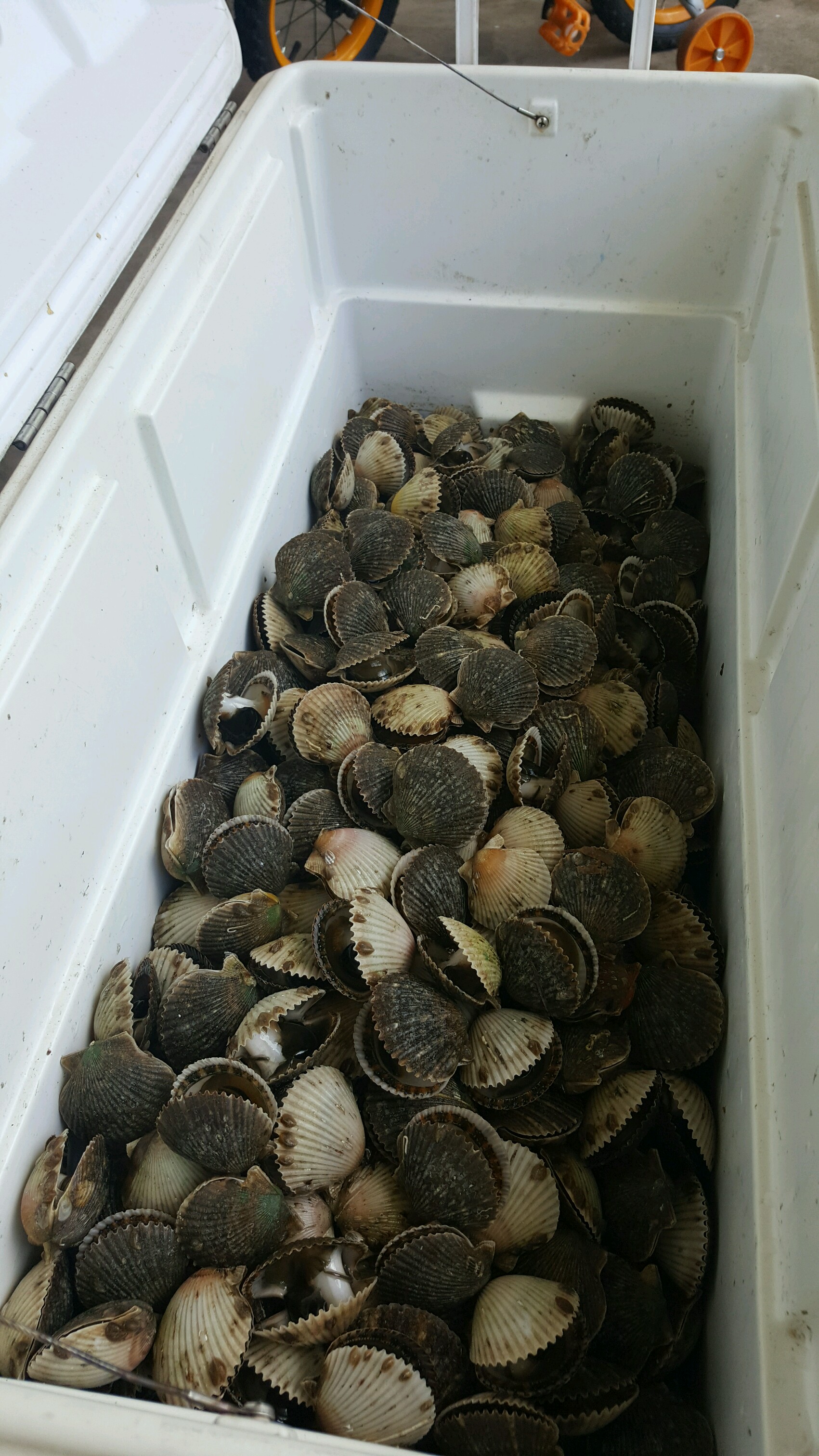
by Erik Lovestrand | Jul 31, 2016
If you have done this phenomenal summertime activity, then you know what I’m talking about. And it’s not just the kids that derive an amazing, nature-based educational experience. Anyone who puts on a mask and snorkel for their first scalloping adventure is about to have their world “rocked” in a good way. Gliding over the shallow seagrass meadows where these bivalves live will produce a sensory experience of sights and sounds like never before.
Florida’s bay scallop (Argopecten irradians), is a mollusk with a well-deserved reputation for being fun to harvest and scrumptious on the dinner plate. However, before you hit the water, there are a few things to consider that will make your scalloping experience safe, enjoyable and educational. Information provided in this article should give you the basics and hopefully encourage you to participate in this Florida Bigbend/Panhandle area’s best reality-show ever!
Know Before You Go: The Florida Fish and Wildlife Conservation Commission governs the rules regarding scalloping zones, license requirements, harvest limits, seasons, gear requirements, and boating laws. For detailed information visit the FWC website on the topic. Take time to review this information so that you are safe and legal when on the water.
Finding the Critters: As always, it is best to know someone who has already been out and can point you to a good location. Barring that scenario, simply search the internet or Facebook, or call the local dive shop or bait and tackle store that sells gear. People are generally very kind in this regard and will at least get you close to the right spots. When you get close, just look for where the boats are gathered. Don’t waste your time trying to find a secluded spot of your own because those boats are there for a good reason. Move at an idle speed and be very careful approaching other vessels. You should be looking for swimmers at all times as some will stray far from their anchored boat with the dive flag displayed. Legally, you are supposed to stay 300 feet from a displayed diver down flag in open waters.
Boat Safe and Smart: The shallow nature of most scallop habitat requires that you understand tidal cycles in the area where you are boating. It is not at all pleasant to be stranded and waiting for the next high tide before you can go home with your catch. In addition to the inconvenience, there are other more serious consequences that may occur in this situation. Often, boaters will realize too late that they have been caught by low water and, whether out of fear or ignorance, start up the motor and attempt to leave in a hurry. This can result in a dangerous grounding at high speed, damage to the vessel or motor, and serious propeller scarring in the very seagrass beds that support the scallops and a host of other amazing species. Best bet, if you can’t put your motor down without it being in the grass, attempt to wade it out to deeper water before starting the motor.
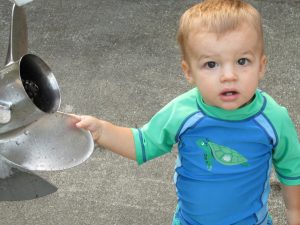
Safety check on equipment before leaving…
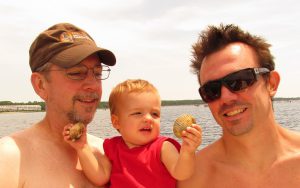
…Often leads to a successful adventure!
Keeping the Catch: If you are not shucking your scallops right on the boat as they are caught you need to protect them for the trip home. The safest way is to place your live scallops on ice in a cooler under shade. When cleaning the catch, it is handy to have a bowl with some ice water handy to drop the meats into for quick chilling. This also keeps them plump and moist for cooking. An old butter knife with a slight bend at the tip works well for shucking and many people even use a spoon if they don’t already have an official scallop knife. Check out this Florida Sea Grant scallop brochure for a couple of tasty recipes for after the shucking is done.
In the end, you are ultimately responsible for whether or not you have a safe, enjoyable experience. So, follow the rules, watch the weather, know the waters where you boat, and have the time of your life. Oh, and take a kid or two along for the comic relief. When you see them surface, squealing with joy at the first bay scallop of their life, I guarantee everyone will be smiling.
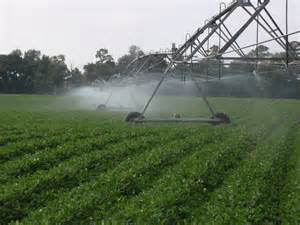
by Rick O'Connor | Jul 31, 2016
On a recent camping trip out west I was made aware of just how valuable water is. The American west has been battling water issues for a few years now. Some camp showers had buttons that would provide you water for a couple of minutes, others charged $.50 for four minutes, some charged $1.00 for four minutes. Not one campsite had water available at the site. You had to walk, load your container, and return. This forced you to be a little wiser on how you used it. You did not want to have to go back and get more very often.
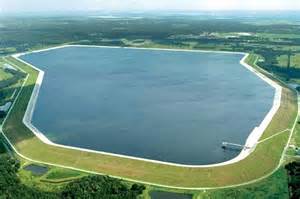
The Bill Young Reservoir in south Florida.
Photo: Southwest Florida Water Management District
However, I was troubled by some of the things I saw as I traveled through the southwest. Areas in the desert where farmers were trying to grow row crops, citrus, and pecans – irrigation systems set up everywhere, reservoirs with canals and dikes to feed much needed water to the farmers… and signs in town where you could buy water to drink at $.25/gallon. It seemed an inefficient use of this resource. It would make more sense to grow crops that used less water, maybe… no water. Recently we have heard a lot about “water wars” and “water rights” in the American southwest. Farmers seeking more, municipalities trying to grab their piece of the pie, football fields and golf courses, and even camp grounds. Some locations you cannot wash your car, or your dogs. It is a real dilemma they are facing. There were numerous creeks and streams I drove over that were absolutely dry, cattle in open rangeland seeking anywhere to find something to drink.
Could this happen in Northwest Florida?
You would think not. In the book Mirage by Cynthia Barnett, it mentions a comment made by Major John Wesley Powell. Major Powell was an ex-confederate officer who was hired by the U.S. Geological Survey to survey land across the south and to the southwest after the Civil War. He mentions problems with developing the American southwest primarily due to the lack of water… but water was something that Florida would never have to worry about – the state was saturated. And yet here we are… 150 years later discussing water rights in Florida. Currently it does not appear to be an issue. At any campground in Florida you will find a water source at each site and you can take a shower as long as you like – at no charge. We are one of the most productive agricultural states in the country – producing row crops, citrus, and cattle. Most in our communities have manicured watered lawns and many have swimming pools. There does not seem to be a problem here. BUT, many communities are beginning to see problems. Salt water intrusion into the water supply, lowering of the water table and aquifers, and even some streams running low. Could we… Florida… the land of water… be heading towards a “water war”?

This is a common method used to irrigate crops across the U.S.
Photo: UF IFAS
The University of Florida Extension Program has recently hired water management specialists in districts across the state. They will be looking at issues that include water quantity and quality to address the needs of each region. These specialists, along with the county faculty, will be working with local residents to discuss the local issues and help mitigate problems that could be looming on the horizon. We encourage all residents to consider how to better manage their water. Think in terms as if you had a set amount each month – budget this to meet your needs – and stick to your budget. Hopefully with research, education, and insight, we can avoid a true “Water War”.
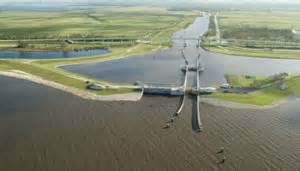
by Rick O'Connor | Jul 31, 2016
Most of us have heard about the toxic algal blooms plaguing south Florida waters. If not, check out http://www.cnbc.com/2016/07/05/. This bloom has caused several major fish kills, bad odors, and has kept tourist away from the area. What happen? and could it happen in the panhandle?

One of the many lock systems that controls water flow in Lake Okeechobee.
Photo: Florida Sea Grant
First we have to understand what happened in south Florida. The source of the problem is Lake Okeechobee. This large freshwater lake has been diked and channeled over the years to supply water to cities and farms in south Florida. The flow of water in and out of the lake is controlled by the Army Corp of Engineers. Typically, this time of year they manage the level of water within the lake to prepare for both the rainy and hurricane seasons. To do this they allow water to flow out into local rivers and canals. However, the water within the lake is heavy with nutrients. Fertilizers, leave matter, and animal waste are discharged into the lake from neighboring communities and agriculture fields. These nutrients fuel the rapid growth of plants and algae, which we call a bloom. These blooms can contain toxic forms of algae that can cause skin irritation and intestinal problems in humans, and can kill many forms of wildlife. Because the state is trying to restore the Everglades, lake water that test high for nutrients cannot be released in a southern direction but rather east and west towards the populated coasts.
But this year was different…
Due to heavy rainfall in spring the Corp had to release more water than they typically would. It was after this release that the large blooms along the east coast began to occur. The state declared a state of emergency and the flow of water out of the lake was altered. But for east Florida, the damage was done.
Could this happen in other parts of the state? Could it happen in the panhandle?
Well first, we have very few controlled water systems for drinking water (reservoirs) so that exact same scenario is a low probability. During a recent trip out west I camped several times along a reservoir designed to hold drinking water for municipalities. At each there were information signs warning swimmers about the potential of high levels of toxic cyanobacteria, particularly in late summer and early fall. But here most of our rivers flow unimpeded (relatively) to the Gulf of Mexico. Our drinking water instead comes from the ground.
But could our local waterways become contaminated with algae?
Yes…
With the situation going on in south Florida people of have pointed fingers at the Corp for releasing too much water. But because the water had high levels of nutrients, others have pointed the finger at the fact that we do not regulate nutrient discharge as well as we should. We have cities and farms here as well, and each produce and release nutrients in the form of leaf litter, animal waste, and fertilizers. Actually large fish kills have happened here. I remember seeing large masses of dead fish on the surface of Bayou Texar in Pensacola when I was younger; Bayou’s Chico and Grande had their problems as well. Most of these were due to excessive nutrients being released from developed areas in the local municipalities.
When I first joined Sea Grant I was told that water quality was a concern in the Pensacola area. Many remembered these large fish kills from a few decades ago and were still concerned about the quality of water in our area, particularly the bayous. I have worked with local non-profits, as well as state and county agencies, and the local high schools to monitor nutrients in the area. The nutrient of concern here is nitrogen. Several groups including the Bream Fishermen’s Association, Escambia County, UF/IFAS LAKEWATCH, and the School District’s Marine Science Academy routinely monitor for nitrogen. Others, such as the University of West Florida and the U.S. EPA, do so when they are working on such projects. Low nitrogen levels could mean less being discharged, but it could also mean that the algae have consumed it – so monitoring for chlorophyll (indicator for the presence of algae) is also important; and these groups do this as well. High levels of algae can trigger declines in dissolved oxygen, so this is monitored also. Low dissolved oxygen can trigger fish kills, and this data is collected by the Florida Fish and Wildlife Conservation Commission. I try to collect as much of this data as I can and post it on our website each Friday on the Escambia County Extension website.
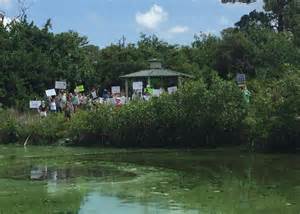
A large algal bloom in a south Florida waterway.
Photo: University of South Florida News
Yes, we have areas with relative high levels of nitrogen, when compared to other locations sampled. Dissolved oxygen levels are typically okay in the Pensacola Bay area, but most of the monitors are sampling in shallow water near shore. A UF/IFAS LAKEWATCH volunteer has recently started to monitor DO at depth in Perdido Bay. In the Pensacola Bay area, fish kills are down when compared to earlier decades.
2016 panhandle fish kills based on data from FWC
- Escambia/Santa Rosa Counties – 8 fish kills – 312 dead fish – cause for most is unknown
- Okaloosa/Walton – 12 fish kills – 1102 dead fish – cause for most is unknown
- Bay – 13 fish kills – 3092 dead fish – 3 of these were attributed to low DO – 2 in White Western Lake, 1 in Grand Lagoon
- Gulf – 5 fish kills – 719 dead fish – cause for most is in unknown – most were starfish
- Franklin – 1 dead sturgeon at St. Vincent Island
- Wakulla – 2 fish kills – 200 dead fish – cause was fishing net dump
- Jefferson – reported no fish kills so far this year.
There are fish kills occurring, the cause of most is unknown, but the numbers are much lower than they were a few decades ago and many are not related to the nutrient issue. However it is true that not all fish kills are reported to FWC. Many residents who discover one are not sure who to call or where to report. If you do discover a fish kill you can report it to the FWC at http://myfwc.com/research/saltwater/health/fish-kills-hotline/. We also experienced a large red tide event this past fall. Though red tides do occur naturally, and 2015 was an El Nino year with unusual rainfall patterns, they can be enhanced with increase nutrients in the run-off.
What we do have a problem with in many areas of the panhandle coast are health advisories. Some agencies, FDEP and Escambia County, monitor for fecal coliform bacteria locally. These are bacteria associated with the digestive system of birds and mammals, including humans, and are non-toxic. However, they are indicators that animal waste is in the water and that pathogenic bacteria associated with animals could be also. When samples are collected the number of bacteria colonies are counted. If the number is above what is allowed a re-sample is taken. If the second count is high as well a health advisory is issued. Many coastal waterways in the panhandle are fighting this problem. Based on FDEP data, the bayous of the Pensacola area average between 8-10 advisories each year. Not all bodies of water are monitored at the same frequency but our bayous are issued advisories between 25-35% of the time they are sampled. Most of the advisories occur after a heavy rainfall, suggesting the source of the animal waste is from run-off, but it could be related to leaky septic tanks systems as well.
So though the scenario that is occurring in south Florida is a low risk for our area, we do have some concerns and there are many things residents and citizens can do to help reduce the risk of a large problem occurring.
- Manage the amount of fertilizer you use. Whether you are a farmer, a lawn care company, or property owner, think about how much you are using and use only what your plants need. For assistance on this, contact your extension office.
- Reduce leaf litter from entering waterways. When raking we recommend you bag your leaves using the new paper bags. These can be composted at the landfill. If you have large amounts of leaves that cannot be bagged, consider composting yourself. The demonstration garden at your local extension office can show you several methods of composting.
- Pick up your animal waste. Our streets and parks are littered with pet waste that owners have not removed, even with the city and county providing plastic bag dispensers to do so. Please be aware of the problem with animal waste and help keep our streets and waterways clean.
- If you have a septic tank, maintain it properly. If you are not sure how to do this, contact your local extension office for advice.
If you have questions about local water quality issues, contact your local county extension office.
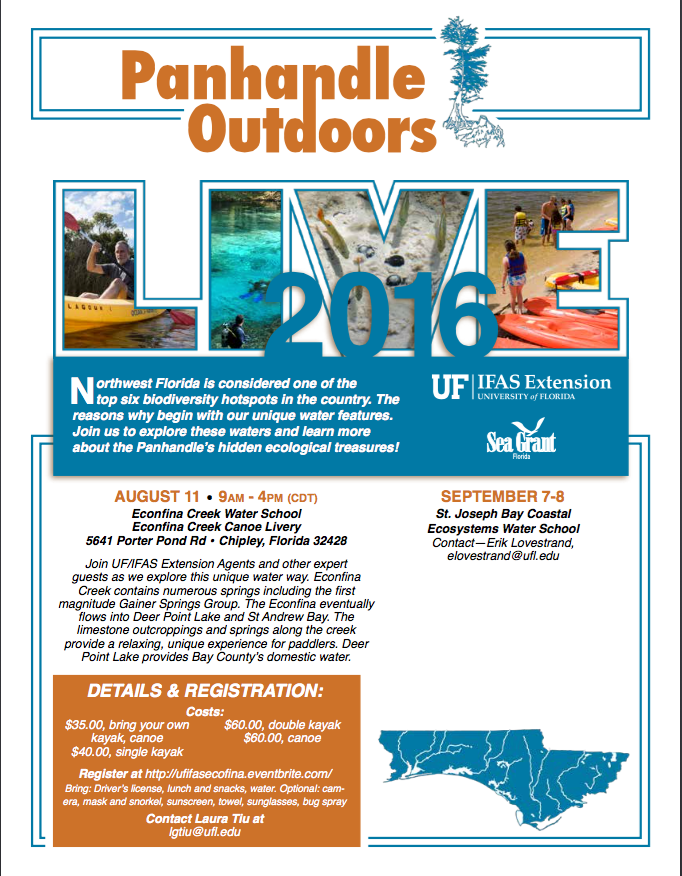
by Rick O'Connor | Jul 27, 2016
Many consider Northwest Florida as the “Canoe Capitol” of the state. We have numerous rivers, creeks, and springs that are great paddling spots. The scenery is great, wildlife is common, and most are easily accessed.
To introduce residents and visitors to the natural history of these waterways, UF/IFAS Extension Agents, and other experts, will lead a paddle trip down one of the many paddling creeks in our area – the Econfina Creek. This creek is one of the more unique ones. The term Econfina is a Muskogean (Creek) term meaning “land bridge” – which apparently existed near the present sight of Highway 20. However, the land bridge is no longer there. This creek runs 22 miles but the upper section is very difficult to paddle. Shallow, fast moving water winds its way through limestone gorges as the land drops at a rate of 7.9 feet / mile (one of the steepest in the state). The lower 6 miles (where our trip takes place) slows, meandering past several springs – including the first magnitude Ganier Springs – limestone outcrops, and lush vegetation – some plant species originate from the Appalachians. There is the chance of seeing some local wildlife including river otters. This lower section is slower and more relaxing and the scenery was graded an “A” by several canoeing guides.
The participants in the program will not only learn about the local natural history of this panhandle waterway but about some of the issues these unique habitats are currently facing. Field experts with the Northwest Florida Water Management District, Florida Fish and Wildlife Commission, and others will share insight to how we can protect these treasured ecosystems. To learn more about the trip contact Dr. Laura Tiu (lgtiu@ufl.edu) or to register visit http://ufifasecofina.eventbrite.com/ .

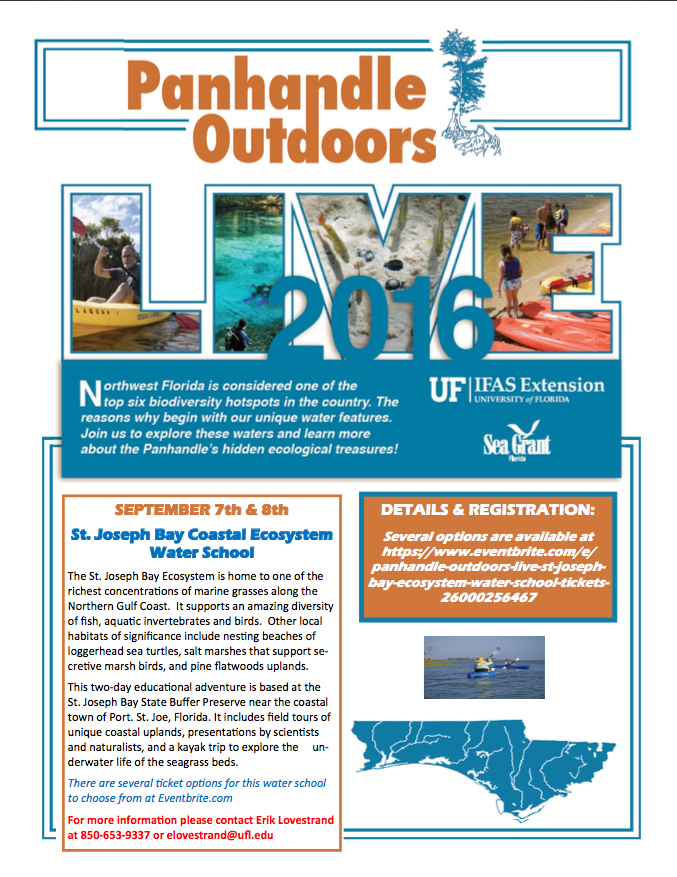
by Rick O'Connor | Jul 27, 2016
Who does not like St. Joseph Bay! What a place… One of the more pristine estuaries in Florida, St. Joe is famous for its snorkeling, fishing, kayaking, and scalloping.
15 miles long and 6 miles across (at its widest point), St. Joe Bay has no significant freshwater input. It’s only opening is to the north and into the Gulf of Mexico. Because of the high salinity in the bay the seagrasses flourish. There are five known species that exist here and the meadows cover almost one sixth of the bottom. Healthy grasses mean diverse wildlife – and St. Joe Bay has it. Migratory birds, octopus, sea turtles, sport fish, urchins, and of course scallops.
The UF/IFAS Extension Natural Resource Agents will be hosting one of their water school programs in St. Joe Bay in September. This two-day program will offer presentations by specialists on a variety of topics, hikes through the uplands, visits to the salt marsh, and a kayak/snorkel trip into the seagrasses themselves. We will be staying at the St. Joseph Bay State Buffer Preserve in Port St. Joe. For more information about this program contact Erik Lovestrand at (850) 653-9337 or elovestrand@ufl.edu.










